Money Matters for Owner-Builders
Understand the difference between estimating and cost planning, and don't let your sweat equity evaporate into budgeting mistakes.
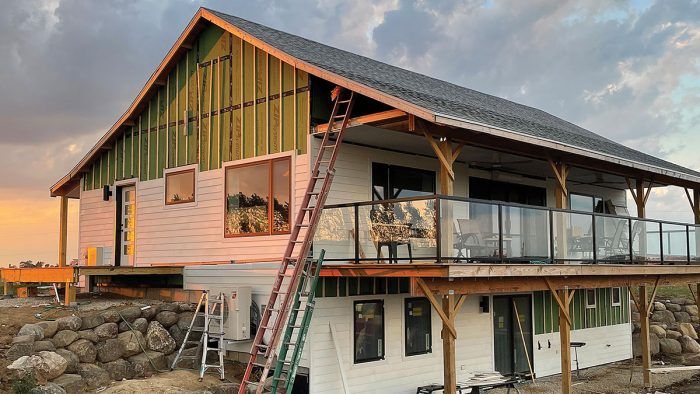
Owner-builder Ian Schwandt describes the cost planning that went into his single-family home build in 2021. He breaks down the actual costs for each item in each phase of the build along with the amount of sweat equity included in each phase, and describes how to plan financially for a project — including financing, design, and sourcing materials and subcontractors — before building begins.
Where It All Began
I grew up on a small farm in Wisconsin in a family that openly discussed the farming business, so much so that as a primary school student my younger brother was able to explain the concept of gross profit to his class. It took me a few more decades to realize the importance of money and how cost planning can make or break your home-building plans. Though it was an overbudget remodeling project that initiated my career pivot toward estimating, I credit my owner-builder experience for showing me that estimating is the part of the cost iceberg that you can see, but cost planning is what lurks beneath the water and sinks ships.
Exterior Finish MaterialComing in at 18% of the total cost of the build, exterior finishes made up the most expensive category. I subcontracted the roofing but performed the siding, windows and doors, painting, and deck-building work myself and with help from many friends and family members. I purchased all the material for this phase from the same building-material supplier that supplied my rough-framing materials.
Exterior Finish Materials Total – $59,869 |
Estimating focuses on determining the cost of a specific part of the project, while cost planning’s goal is to create a framework for making decisions about the execution of a project from the design concept phase on through the build stage. It is this framework that allows the owner-builder to make informed decisions, and avoid reactionary planning.
I speak from experience as an owner-builder. My wife, Sara, and I built a 2750-sq.-ft. house in 2021 with a budget of $100 per sq. ft. This budget, which I will detail here, was for the house build only and does not include the cost of land—and as you can see, this is way below the national average for a custom home. This reduced cost would only be achievable in a frugal owner-builder project.
Sitework and Site ImprovementsMy house site started off as a farm field in a rural township. Electricity needed to be brought to the site by the local utility, whose engineers worked directly with me to determine the most cost-effective way to bring in the power without disrupting the design. Water and sewer service was established by digging a 250-ft.-deep well and installing a mound septic system sized for a three-bedroom house. The work was executed by reputable local firms who were amongst the first subcontractors that I signed up early in the planning stage. Excavation, final grade, retaining walls, and the driveway were done by the same contractor who installed the septic. The total cost represented 14% of my build cost.
Sitework Total – $46,754 |
I kept a detailed spreadsheet throughout my design process that had estimated costs for each phase of the build, and I tracked the actual costs against that estimate. For the work that I needed to hire out, I got subcontractors involved early in the process, reaching out to some key subcontractors like my excavation company, JF Trucking & Trenching, while I still lived in New York. These subcontractors were able to provide me with cost ranges that I plugged into my spreadsheet along with the material takeoffs for my self-performed work.
In this article I will give an overview of what I spent on each part of the build and the decision-making process that I used to plan the spending. If you are searching for more information about singular parts of the build, I wrote extensively about the experience of building my home as the 2021 FHB House, and builder Jon Beer has produced similar articles for his 2023 FHB House project. You can find both at FineHomebuilding.com/fhb-house.
Foundation and ConcreteI used a small local contractor who specializes in building agricultural buildings and does concrete work as a side business during the warm weather months. He was flexible and allowed me to set the footing formwork to keep the schedule moving, plus I helped on the wall, basement floor, and garage floor pours. In addition, I executed the concrete waterproofing myself using a concrete waterproofing system from W. R. Meadows purchased through a local specialty concrete supply house. The 120 hours I spent on this scope kept the overall cost down to 7% of the build cost.
Foundation and Concrete Total – $24,480 |
Plans, Permits, and Loans
Thanks to numerous websites dedicated to tracking the buying and selling of real estate, we live in a golden age of cost data. You can track the prices paid for new and existing homes that will help you develop your own home design with an understanding of what features of a home your local market values above others. Parade of Homes tours and home-building trade shows offer the owner-builder opportunities to network with future contractors, subcontractors, and vendors and to get ideas for building features that can help solidify a design.
Rough FramingThis is where developing a relationship with a lumberyard was crucial to my success. By purchasing all my rough-framing materials and roof trusses from a single supplier, I was able to take advantage of their in-house engineering services. They took my design and provided me with the floor system, wall, and roof engineering to satisfy my building inspector, who required this information during the permitting stage. I used Zip System sheathing for the roof and wall sheathing as well as LSL studs that allowed me to build 11-ft.-tall eave walls without additional engineering. Along with family members and friends, I worked approximately 800 hours on the rough-framing project scope, bringing the cost in at 15% of the build cost.
Rough Framing Total — $49,456 |
Speaking of design, you need a set of construction drawings that express your design to build a house. This is a necessary part of executing an owner build successfully. This does not mean that you need an architect or a set of purchased plans, but you need a set of drawings that gives the parameters for the main cost driver of the project—the home’s foundation and structure. The drawings can be high level and light on finish details, but without a drawing set that you can use to communicate with vendors, you will not be able to secure cost information that forms the basis for your cost planning. For example, lumber salespeople are generally skilled at producing a material estimate that can include everything from sill seal and framing lumber to a trim package and a fastener allowance. But they need a set of plans to do it. When vendors and contractors have a clear understanding of your build, they can be trusted advisors and make up a critical part of your toolkit as you move to plan the execution phase of your project.
InsulationOther than the 4 in. of closed-cell spray foam applied to the underside of my roof deck, I installed all the underslab EPS, dense-pack cellulose in the walls, and fiberglass batts in the roof assembly. Though this cost came in at 5% of the total, I now view the 120 hours that I spent executing the scope as not worth the effort. My experience in cost planning since this build has proven that it is challenging to do large whole-home insulation work for less money and time than a professional contractor.
Insulation Total – $16,676 |
Building officials and bank officers are a variable part of the planning process, but can be important advisors to the owner-builder too. While zoning regulations vary across the country, most municipalities require that a building meet the locally accepted building codes, and often the local building official, who is responsible for issuing the building permit and performing inspections of the building work, can be an asset in helping the owner-builder make sure the planned build complies with all regulations.
HVACWhile electrical and plumbing work required hiring professionals, my municipality allowed me to self-perform the HVAC work. I used an online supplier to source all the hydronic supplies including my boiler and had a local contractor install my Hyper-Heating Mitsubishi multi-spilt system. Installing my own in-floor heat was challenging, but my 170 hours kept this cost at 4% of the total project cost.
HVAC Total — $14,00 |
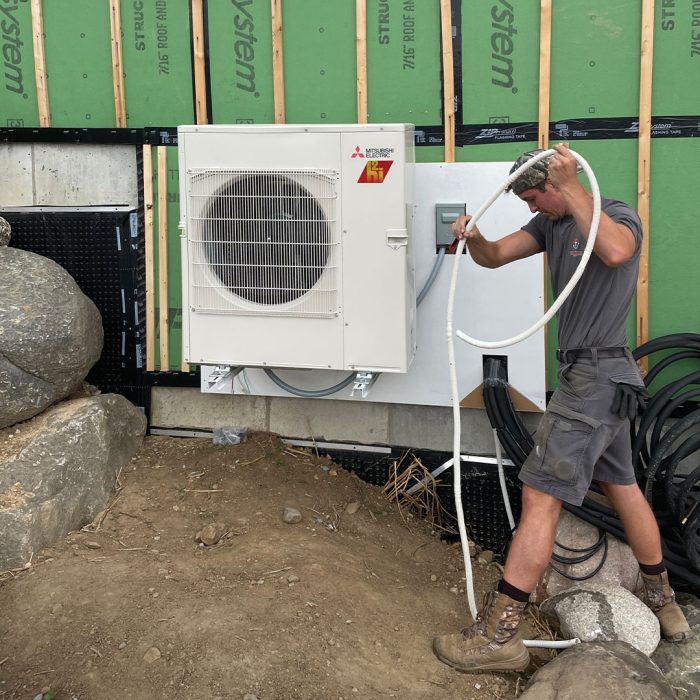
If a construction loan is in your future, it is crucial to find a bank with construction-lending experience that is willing to lend to owner-builders. Not all banks have a business model that allows them to take on the risk that comes with an owner-built project. Meeting with multiple banks to discuss your project in detail is a necessary part of financing an owner-built project. Bankers who are well versed in construction lending will be looking to you, the owner-builder, to confidently provide them with answers to their cost-planning questions to prove that your project is worthy of their investment and risk.
DrywallMy home contains a bit over 8000 sq. ft. of drywalled surface that I contracted out to a metro-area contractor that specialized in new-construction drywall. This ended up at 6% of my build cost. Originally, I had planned to execute the work on my own with help from friends since the material cost was a small fraction of the work. Though I had to wait a few weeks for schedule availability, the time it saved made this one of the better cost vs. time decisions that I made.
Drywall Total — $20,692 |
With our design finalized and my budget spreadsheet complete in August of 2020, we secured financing via a construction loan for $250,000 for our house. This $250,000 figure was based on 80% of our bank’s expected appraised value of our design at $312,500. The 80/20 loan-to-value matrix is very common in residential mortgage lending. I budgeted an additional $25,000 out of pocket, resulting in my self-design-build budget of $100 per sq. ft. As material costs steadily rose throughout the second half of 2020 and the first half of 2021, we faced a realization that to meet our budget we would either need to drastically value-engineer our interior finishes or possibly not build a portion of the project. The other option was to increase our budget. After looking at the new construction appraisal our bank provided and comparing it to what new homes and newly remodeled homes were selling for in our area, we felt that increasing our budget was worth the risk.
Electrical & PlumbingPer my local municipality, both electrical and plumbing work needed to be performed by licensed professionals. Each of these two categories came in at 7% of the total cost. Finding a plumber was particularly challenging for my build. I found a metro-area plumber who was willing to give me a price for the project that I used for my construction-loan cost planning. I continued looking for other options and soon after I broke ground, I was able to find a father-son plumbing team with the schedule capacity to take on my project at a reduced price from the metro-area contractor.
Electrical & Plumbing Total — $50,082 |
I started planning my build in 2019 and approached it with a carpenter’s and estimator’s mindset. Working through the process of designing, sourcing materials and subs, financing, and then finally building the house shifted this mindset toward cost planning. Not only did this shift my thinking about my trade, but it shifted my career path to focus as much on the financial planning for a project as I previously had on the physical execution. As much as I take pride in having built my own home, I take great personal satisfaction in having done it in a financially responsible way.
Interior FinishesBy their nature, interior finishes happen at the end of the project. As material costs increased during our build and started to drain our funds, we used our prior cost planning as a guide for where to keep the material spec as-is—tile, wood flooring, and appliances—and where to drop to lower-cost options that could be swapped out later—site-built cabinets, interior doors and trim, and painting. These decisions, plus 700 hours of my own work, brought interior finishes in at 14% of the total build.
Interior Finishes Total – $48,912 |
The Significance of Sweat Equity
In addition to the monetary cost, a large self-built project like this comes with a cost measured in time. During the build, I worked 20 hours a week at my job as an estimator and project developer for TDS Custom Construction, and my wife, Sara, worked full time. Between the two of us, our fathers, and a few friends, we worked about 3000 hours on the project. It would be easy for an observer to say that these hours need to be converted into dollars to give a true cost for the project, but I feel that this line of thinking misses the point and the spirit of self-building. We, like most of the self-builders you can find on social media, have chosen this path because it is the only way we know to achieve the desired result.
That said, below is a rough breakdown of the hours we put into each of the phases discussed in this article. Though on paper this looks like a daunting outlay for two people in one year, the decision to self-build as opposed to buy was an easy one. Having previously remodeled one house to the best of our abilities, and having been exposed to many interesting architectural styles through my interior carpentry work, we had a clear vision for what we wanted our home to be. Add in my desire for an energy-efficient high-performance home and our access to buildable land, and the choice to build new was clear. In the end, the added cost in dollars and time of building our house as a double-wall construction, high-performance home was negligible.
Building Phases & Hours
Total Hours – Approximately 3,000 |
The extra air-sealing, framing, insulating, and mechanicals added about a month’s worth of work, 160 hours, and $10,000 in extra material—the bulk of dollars was spent on framing for the double wall and extra insulation. I am often asked, “Would you do it again?” There were certainly times when stress levels were through the roof, money was tight, and our patience was shot. At those times, I would have answered, “No way, not a chance.” Having come out on the other side with a house of my own design, built with my own hands and the hands of my family, at a cost that I was able to shoulder, I can now answer that question with an emphatic, “Yes.”
— Ian Schwandt is production manager for TDS Custom Construction in Madison, Wis., and a Fine Homebuilding contributing editor. Photos by FHB Staff.
RELATED STORIES
- Thoughts for Owner-High-Performance Builders (GBA)
- Advice For Future Owner-Builders
- Lessons Learned by a First-Time Owner-Builder
Fine Homebuilding Recommended Products
Fine Homebuilding receives a commission for items purchased through links on this site, including Amazon Associates and other affiliate advertising programs.
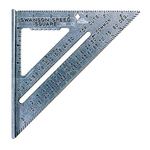
Original Speed Square
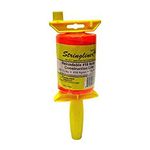
Smart String Line

100-ft. Tape Measure
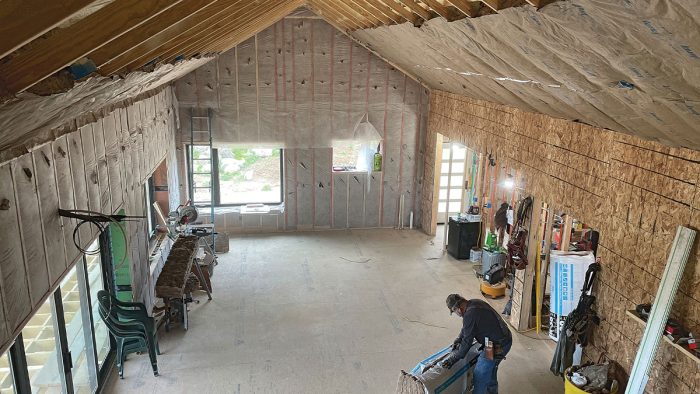

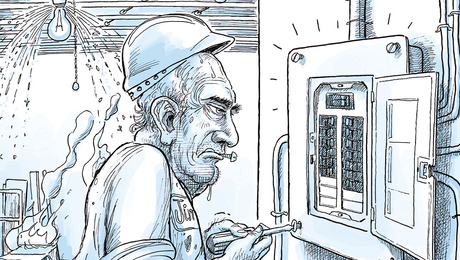







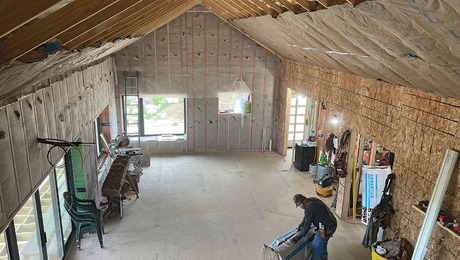



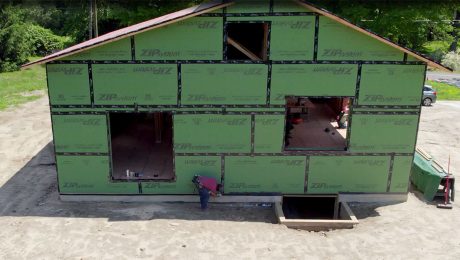











View Comments
One of the most rewarding parts about this project has been sharing the process on this blog. And sharing this raw cost data has been something that was important to me from the start. If anyone has questions or is interested in additional background to this cost data please reach out via the comments.
Thanks
Ian
Hey Ian, this is such a helpful article. Looking forward to digging into more of the things you've written on your build. I'm curious if you have suggestions on a template for keeping this spreadsheet data, as well as a rough sequence of events for the build. My wife and I are going the OB route starting in August. The bank is giving us 12 months, so we'll see how it goes. Excited/nervous/petrified is how I would describe my feelings right now.
Thank you! It is rewarding to hear that. Feel free to email me at [email protected] and I will share the sheet that I used. Happy to answer any other questions that you may have as well. Congrats on finding a bank!
Enjoyed hearing and reading about the process so far. I don't recall if you mentioned this on the podcast at all - but did you do smart framing for your walls/doors/windows?
Also, on the framing did you do any type of drywall gasket like the DOW drywall gasket, or did you only rely on the zip + foam for penetrations for exterior air sealing?
I did double wall framing 16 o.c. 2x6 bearing wall for the exterior and non bearing 2x4 wall interior. For the window and door air sealing I installed the windows in the drainplane by installing the 1x drainplane strapping on the outside of the window opening which is lined with Zip sheathing buck on all sides. I uses Zip Tape to flash/seal the strapping to the Zip face of the wall and the buck the top and side flanges of the window is taped with Zip Tape, insulated with Rockwool and then taped on the inside to the window buck on all four sides with ProClima Profect tape from Passive House Building. I can't say enough about how well this tape air seals the windows. No interior trim all drywall returns. No drywall gaskets anywhere but I did seal plates with acoustical sealant and the disc lights have gaskets.
Thanks for following the project!
Ian
Good job, sounds like a good plan and great price. We did a similar thing, built a double-stud 2150 sq ft house full basement, did a lot of work ourselves but also hired quite a bit. I also kept a spreadsheet but it hasn't been updated for a while. But I think we are in the same ballpark as you. Looks like you got away with not doing any stormwater management, which in our case cost $15K-$20K, but you were required to do a sand mound at similar expense while we lucked out and have a conventional system.
Hard to compare without some more details.
Curious about your window package. How many windows did you have? Any large expensive windows? What U-value and air leakage ratings did you have? We did U 0.16 windows from ProVia in Ohio.
What were your insulation values? 10/20/40/60? (underslab/basement walls/main walls/ceiling)?
Our house had some timber framing (which I did), only a couple posts, mostly horizontal members that rested on the double-stud wall. We also decided to get a custom-built kitchen from an Amish outfit down the road. That was well over $15K.
Would I do it again? No, once was enough. I like doing weekend size projects, but I didn't like doing weekend size projects every day for 2 years (I'm retired so probably not as limber or fast as you). As well as retired, I'm just plain tired too. And no, I won't do it again as I don't plan to move again in this life.
Dennis,
Thanks for the comments!
12 windows total. 2 patio doors. 3 of the windows in the great room are 60"x84" They were not that expensive. Under $1500 each if memory serves. Our large OXXO patio door was about $5K that was the big expense.
U-Value on the Marvin Essentials is .29 and our overall air leakage based on a pre-insulation blower door test beat passive house standard. Still hoping to do another test now that everything is done.
Insulation values 20/30/45/64
Thanks again,
Ian
While Ian's family self build is a commendable job, the article 's title, like many articles featured in F.H. is misleading and delusional. To claim that this project was tracked to the penny per square foot while providing only rounded numbers on labor is disingenuous at best. Beyond that fact, if you factor the 3000 undocumented hours into a real life labor rate of, say, $60 hr. then the home cost roughly $200/sq. ft. to build. A nice, quality built home no doubt. But nothing to write home about...certainly when expressed to the penny. This proves to me that the title is meant to capture the imagination of the DIY that this magazine has moved toward catering to over the past 10 years. Its all about selling product by the magazine's advertisers rather than how to professional build and/or remodel a real fine home.
Shorter deadnuts: Shut FHB all down and have a contractor build your house.
thanks for all the information. as a non builder there is a lot of jargon and detail I would like to drill into. Are you thinking of doing sub podcasts or articles breaking down this info. Example is the window installation with the double walls. I know this can be particularly challenging. And we see 6 different ways from 5 different authors.
Hello
We did a window install video earlier in the series that details the flashing and window install steps. Was there anything in particular that you were looking for more information on?
Thanks
Ian
Does your final price figure include any of the garage?
I've been through all of your articles and videos. Not much information about the garage.
I am also a contractor and will begin building my own self designed home this spring.
Thanks
It does include the garage which is 32' wide and 30' deep. 2x6 walls insulated with fiberglass, typical trusses with blown in cellulose and a heated slab. We built the extra depth to as space for a commercial kitchen and walk in cooler for my wife. Currently the extra depth is acting as my shop until we build a pole barn this summer. Good luck with your build and please reach out with any questions.
Thanks,
Ian